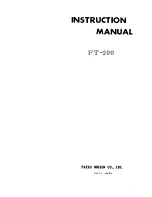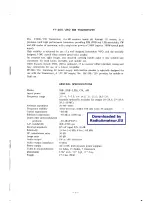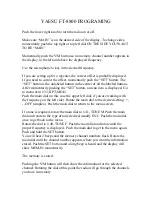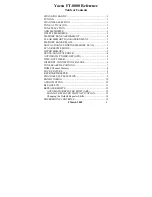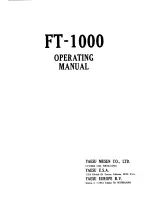
CIRCUIT DESCRIPTION
6-8
September 1994
Part No. 001-2008-300
Both the N and A counters begin counting down
from their programmed number. When the A counter
reaches zero, it halts until the N counter reaches zero.
Both counters then reset and the cycle repeats. The A
counter is always programmed with a smaller number
than the N counter. While the A counter is counting
down, the prescaler divides by 65. Then when the A
counter is halted, the prescaler divides by 64.
Example: To illustrate the operation of these
counters, assume a transmit frequency of 858.4875
MHz (channel 300). Since the VCO is the channel
frequency for transmit this frequency is used. To pro-
duce this frequency, the N and A counters are pro-
grammed as follows:
N = 1073 A = 7
To determine the overall divide number of the
prescaler and N counter, the number of VCO output
pulses required to produce one N counter output pulse
can be counted. In this example, the prescaler divides
by 65 for 65 x 7 or 455 input pulses. It then divides
by 64 for 64 x (1073 - 7) or 68,224 input pulses. The
overall divide number K is therefore (68,224 + 455) or
68,679. The VCO frequency of 858.4875 MHz
divided by 68,679 equals 12.5 kHz which is the f
R
input to the phase detector. The overall divide number
K can also be determined by the following formula:
K = 64N + A
Where,
N = N counter divide number and
A = A counter divide number.
NOTE: Section 8.2.5 describes how the N and A
counter numbers can be calculated for other channels.
6.2.6 LOCK DETECT
When the synthesizer is locked on frequency, the
Lock Detect output on U403, pin 2 is a high voltage
with narrow negative-going pulses. When the synthe-
sizer is unlocked, the negative-going pulses are much
wider.
The lock detect pulses are applied to J401, pin 16
and sent to the RF Interface on J102, pin 16 for detec-
tion and sampling in the IAC.
6.2.7 BUFFER AMPLIFIER (Q410, Q411)
A cascode amplifier formed by Q410 and Q411
provides amplification and also isolation between the
VCO and exciter RF stages. A cascode amplifier is
used because it provides reverse isolation. The input
signal to this amplifier is tapped from VCO A007.
C441 provides DC blocking. Bias for the amplifier is
provided by R464, R465, R466, R467 and R468.
L406 is an RF choke and R483 lowers the Q of the
coil. RF bypass is provided by C434, C442, C445,
C443, C444 and C480. The output of Q410/Q411 is
matched to the exciter RF stages by C446, R460 and
two sections of microstrip.
6.2.8 RF AMPLIFIERS (Q412, Q413)
RF amplifier Q412 is biased by R469, R470 and
R472. AC ground is provided by C450. C448 pro-
vides RF bypass from the DC line and R471 provides
supply voltage isolation. A section of microstrip on
the collector acts as an RF inductor. Q412 is matched
to Q413 by C449, C451 and two sections of micros-
trip.
RF amplifier/buffer Q413 is similar in design to
Q412. The collector voltage of Q413 is switched by
Q405. When the Logic Push-To-Talk (LPTT) on
J401, pin 11 is low Q405 turns on and conducts the
15V supply to the collector of Q405 and to Q413. The
output of Q413 is matched to 50 ohms by two sections
of microstrip and C465 provides DC blocking. The
RF output of the exciter is on coaxial connector J402
to the power amplifier.
6.3 POWER AMPLIFIER
6.3.1 AMPLIFIER/PRE-DRIVER (U501)
RF input to the PA from the Exciter is through a
coaxial cable and connector to WO511. C501 couples
the RF to 50 ohm microstrip that connects the input to
U501. U501 is a 6W amplifier/pre- driver operating
in the 851-869 MHz range.
Power control is connected to WO505 from the
RF Interface board (RFIB). RF is filtered from the
control voltage line by various capacitors and induc-
tors to U501, pin 2. This control voltage regulates the
RF output of the amplifier on U501, pin 4 to approxi-
mately 5W.
Содержание Viking VX Series
Страница 2: ......
Страница 4: ......
Страница 20: ...INTRODUCTION AND OPERATION 1 8 September 1994 Part No 001 2008 300 This page intentionally left blank...























